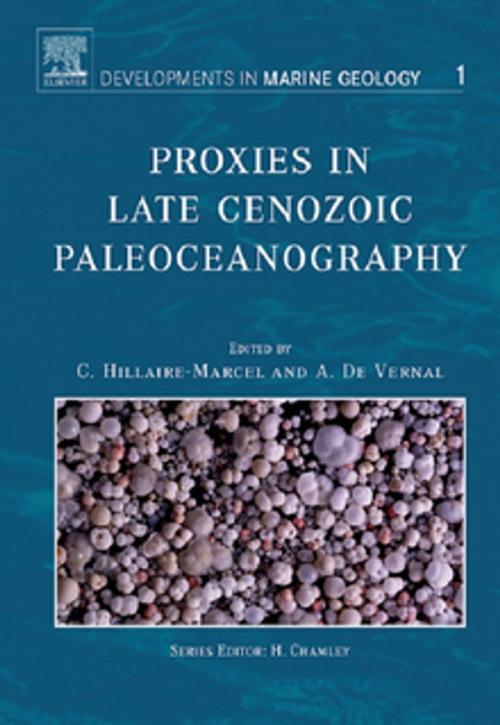Proxies in Late Cenozoic Paleoceanography
Nonfiction, Science & Nature, Science, Earth Sciences, Palaeontology, Geology| Author: | ISBN: | 9780080525044 | |
| Publisher: | Elsevier Science | Publication: | May 25, 2007 |
| Imprint: | Elsevier Science | Language: | English |
| Author: | |
| ISBN: | 9780080525044 |
| Publisher: | Elsevier Science |
| Publication: | May 25, 2007 |
| Imprint: | Elsevier Science |
| Language: | English |
The present volume is the first in a series of two books dedicated to the paleoceanography of the Late Cenozoic ocean. The need for an updated synthesis on paleoceanographic science is urgent, owing to the huge and very diversified progress made in this domain during the last decade. In addition, no comprehensive monography still exists in this domain. This is quite incomprehensible in view of the contribution of paleoceanographic research to our present understanding of the dynamics of the climate-ocean system. The focus on the Late Cenozoic ocean responds to two constraints. Firstly, most quantitative methods, notably those based on micropaleontological approaches, cannot be used back in time beyond a few million years at most. Secondly, the last few million years, with their strong climate oscillations, show specific high frequency changes of the ocean with a relatively reduced influcence of tectonics.
The first volume addresses quantitative methodologies to reconstruct the dynamics of the ocean andthe second, major aspects of the ocean system (thermohaline circulation, carbon cycle, productivity, sea level etc.) and will also present regional synthesis about the paleoceanography of major the oceanic basins. In both cases, the focus is the “open ocean leaving aside nearshore processes that depend too much onlocal conditions. In this first volume, we have gathered up-to-date methodologies for the measurement and quantitative interpretation of tracers and proxies in deep sea sediments that allow reconstruction of a few key past-properties of the ocean( temperature, salinity, sea-ice cover, seasonal gradients, pH, ventilation, oceanic currents, thermohaline circulation, and paleoproductivity).
Chapters encompass physical methods (conventional grain-size studies, tomodensitometry, magnetic and mineralogical properties), most current biological proxies (planktic and benthic foraminifers, deep sea corals, diatoms, coccoliths, dinocysts and biomarkers) and key geochemical tracers (trace elements, stable isotopes, radiogenic isotopes, and U-series). Contributors to the book and members of the review panel are among the best scientists in their specialty. They represent major European and North American laboratories and thus provide a priori guarantees to the quality and updat of the entire book. Scientists and graduate students in paleoclimatology, paleoceanography, climate modeling, and undergraduate and graduate students in marine geology represent the target audience.
This volume should be of interest for scientists involved in several international programs, such as those linked to the IPCC (IODP – Integrated Ocean Drilling Program; PAGES – Past Global Changes; IMAGES – Marine Global Changes; PMIP: Paleoclimate Intercomparison Project; several IGCP projects etc.), That is, all programs that require access to time series illustrating changes in the climate-ocean system.
- Presents updated techniques and methods in paleoceanography
- Reviews the state-of-the-art interpretation of proxies used for quantitative reconstruction of the climate-ocean system
- Acts as a supplement for undergraduate and graduate courses in paleoceanography and marine geology
The present volume is the first in a series of two books dedicated to the paleoceanography of the Late Cenozoic ocean. The need for an updated synthesis on paleoceanographic science is urgent, owing to the huge and very diversified progress made in this domain during the last decade. In addition, no comprehensive monography still exists in this domain. This is quite incomprehensible in view of the contribution of paleoceanographic research to our present understanding of the dynamics of the climate-ocean system. The focus on the Late Cenozoic ocean responds to two constraints. Firstly, most quantitative methods, notably those based on micropaleontological approaches, cannot be used back in time beyond a few million years at most. Secondly, the last few million years, with their strong climate oscillations, show specific high frequency changes of the ocean with a relatively reduced influcence of tectonics.
The first volume addresses quantitative methodologies to reconstruct the dynamics of the ocean andthe second, major aspects of the ocean system (thermohaline circulation, carbon cycle, productivity, sea level etc.) and will also present regional synthesis about the paleoceanography of major the oceanic basins. In both cases, the focus is the “open ocean leaving aside nearshore processes that depend too much onlocal conditions. In this first volume, we have gathered up-to-date methodologies for the measurement and quantitative interpretation of tracers and proxies in deep sea sediments that allow reconstruction of a few key past-properties of the ocean( temperature, salinity, sea-ice cover, seasonal gradients, pH, ventilation, oceanic currents, thermohaline circulation, and paleoproductivity).
Chapters encompass physical methods (conventional grain-size studies, tomodensitometry, magnetic and mineralogical properties), most current biological proxies (planktic and benthic foraminifers, deep sea corals, diatoms, coccoliths, dinocysts and biomarkers) and key geochemical tracers (trace elements, stable isotopes, radiogenic isotopes, and U-series). Contributors to the book and members of the review panel are among the best scientists in their specialty. They represent major European and North American laboratories and thus provide a priori guarantees to the quality and updat of the entire book. Scientists and graduate students in paleoclimatology, paleoceanography, climate modeling, and undergraduate and graduate students in marine geology represent the target audience.
This volume should be of interest for scientists involved in several international programs, such as those linked to the IPCC (IODP – Integrated Ocean Drilling Program; PAGES – Past Global Changes; IMAGES – Marine Global Changes; PMIP: Paleoclimate Intercomparison Project; several IGCP projects etc.), That is, all programs that require access to time series illustrating changes in the climate-ocean system.
- Presents updated techniques and methods in paleoceanography
- Reviews the state-of-the-art interpretation of proxies used for quantitative reconstruction of the climate-ocean system
- Acts as a supplement for undergraduate and graduate courses in paleoceanography and marine geology















